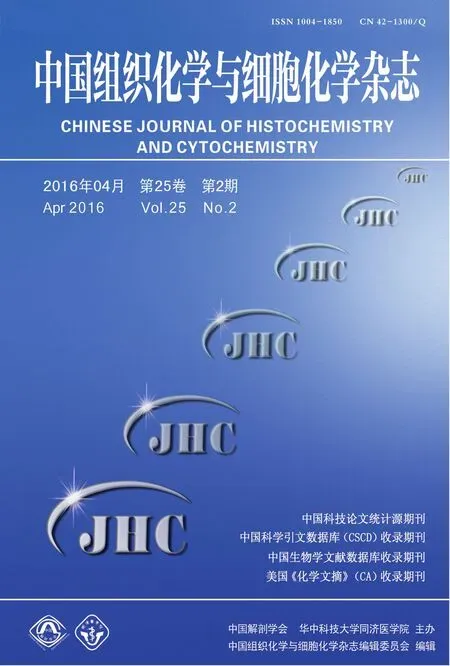oHSV1-hTERT-GFP法检测小细胞肺癌循环肿瘤细胞
2016-09-15云张文杨绍兴刘滨磊张开泰
王 云张 文杨绍兴刘滨磊*张开泰*
(中国医学科学院1北京协和医学院肿瘤医院病因及癌变研究室,2中国医学科学院肿瘤医院免疫学研究室;3中国人民解放军第307医院肺部肿瘤内科;北京 100021)
oHSV1-hTERT-GFP法检测小细胞肺癌循环肿瘤细胞
王 云1张 文2杨绍兴3刘滨磊2*张开泰1*
(中国医学科学院1北京协和医学院肿瘤医院病因及癌变研究室,
2中国医学科学院肿瘤医院免疫学研究室;3中国人民解放军第307医院肺部肿瘤内科;北京 100021)
目的 在正常人体细胞中活性被抑制的端粒酶,在肿瘤细胞中处于活化状态,可以特异性示踪循环肿瘤细胞。本研究拟建立基于插入人端粒酶启动子和绿色荧光蛋白(green fluorescent protein,GFP)基因的单纯疱疹病毒(oHSV1-hTERTGFP)检测小细胞肺癌(small cell lung cancer,SCLC)外周血中循环肿瘤细胞的方法。方法 观察SCLC细胞在感染病毒oHSV1-hTERT-GFP后的荧光强度来判断GFP的表达,通过建立SCLC循环肿瘤细胞模型,用oHSV1-hTERT-GF法检测CD45-/ GFP+细胞,分析此法对SCLC细胞的捕获效率和可重复性;通过CD56与GFP进行共定位来验证oHSV1-hTERT-GFP对SCLC细胞示踪的特异性;应用oHSV1-hTERT-GFP法检测50例正常人和10例广泛期SCLC病人治疗前后的外周血中CD45-/GFP+细胞数,分析此法检测正常人与SCLC病人CD45-/GFP+细胞数的差异和SCLC病人治疗前后CD45-/GFP+细胞数变化,并将oHSV1-hTERT-GFP法检测的循环肿瘤细胞数量变化与临床疗效进行对比分析。结果 感染病毒oHSV1-hTERT-GFP后24h的SCLC细胞GFP表达量较感染后16h显著增加;模型实验结果显示oHSV1-hTERT-GFP法检测循环肿瘤细胞的效率与其在外周血中的含量无关;oHSV1-hTERT-GFP病毒捕获的细胞与CD56共定位,oHSV1-hTERT-GFP捕获SCLC细胞的特异性高。临床实验中,SCLC病人外周血中的CD45-/GFP+细胞数比健康人显著增加;在病情缓解的病例中,治疗后CD45-/GFP+细胞数较治疗前显著下降。结论 基于oHSV1-hTERT-GFP的检测方法能够识别和鉴定出SCLC外周血中的循环肿瘤细胞,对SCLC的复发转移以及疗效评价等有一定临床应用价值。
循环肿瘤细胞;单纯疱疹病毒;转移;人端粒酶逆转录酶;小细胞肺癌
小细胞肺癌(small cell lung cancer,SCLC)占肺癌15%左右,其中广泛期占60%以上[1],对化疗、放疗敏感,初治缓解率高,但极易出现继发性耐药、复发、远处转移[2],5年生存率不到5%[3]。近些年来,循环肿瘤细胞(circulating tumor cells,CTCs)成为肿瘤的“液体活检”对象。对CTCs的检测有助于肿瘤的早期发现、疗效评估,以及预后判断[4-5,12]。SCLC在细胞学上呈现出多种形态,细胞大小差异大,往往缺乏突出的核仁和细胞边界[6],因此无法采用基于物理学特征的方法从SCLC外周血中分离肿瘤细胞。SCLC属于非上皮来源的神经内分泌肿瘤,在耐药和转移的过程中易出现上皮细胞-间充质转化(epithelial-mesenchymal transition,EMT)[7-10],所以通过基于细胞表面标记物的方法,如CellSearch System,难以捕获SCLC外周血中的CTCs。
端粒酶在正常人体细胞中的活性被抑制,而在90%以上的肿瘤细胞中处于活化状态[11],因此可以利用检测端粒酶活性的方法来示踪CTCs。本研究利用插入人端粒酶启动子和绿色荧光蛋白(green fluorescent protein,GFP)基因的单纯疱疹病毒(oHSV1-hTERT-GFP)作为示踪手段,观察该技术对外周血中SCLC细胞的捕获能力[12]。
材料和方法
1 病毒oHSV1-hTERT-GFP的构建
敲除1型单纯疱疹病毒(oHSV1)基因ICP34.5,并替换成GFP表达盒。细胞感染此病毒后,可以在端粒酶逆转录酶的作用下激活下游基因GFP的表达[12]。
2 细胞培养
人高转移肺癌细胞系95D(ATCC,USA),人SCLC细胞系 NCI-H69(ATCC,USA),NCI-H446(ATCC,USA)在浓度为10%胎牛血清(fetal calf serum,FBS)的RPMI-1640(Invitrogen,USA)完全培养基中置于5%CO2、37℃条件下培养。人SCLC细胞系NCI-H209(ATCC,USA)在浓度为20%FBS的RPMI-1640(Invitrogen,USA)完全培养基中置于5%CO2、37℃条件下培养。
3 激光扫描共聚焦显微镜标本制备
分别将 SCLC肿瘤细胞系和标本(收集1例SCLC病人的外周血,裂解红细胞,提取有核细胞)按MOI=1感染oHSV1-hTERT-GFP,24h后涂片,将PE-Cy5标记的抗人CD56(BD,USA)加到涂有细胞的载玻片上于湿盒中4℃孵育过夜,DAPI细胞核染色封片后,激光扫描共聚焦显微镜观察和采集图像。
4 流式细胞分析标本制备
收集中国人民解放军第307医院内科经治疗后病情完全缓解(CR)或部分缓解(PR)的广泛期小细胞肺癌(extensive disease small cell lung cancer,EDSCLC)病人外周血样本10例,采集50例健康体检的正常人外周血样本作为对照。用EDTA-K2抗凝采血管收集患者外周血4ml,红细胞裂解液(NH4Cl,0.15mol/l;EDTA,0.1mmol/l;KHCO3,10mmol/l;pH 7.2)室温裂解5min,离心后弃上清,PBS洗涤细胞后用4ml无血清培养基重悬细胞,按照MOI=1比例感染细胞,37℃、5%CO2孵育1h后补充4ml浓度为10%胎牛血清的RPMI-1640(Invitrogen,USA)完全培养基,24h后收集细胞,用200μl PE-Cy5标记的抗人CD45(BD,USA)抗体室温避光孵育30min,PBS洗涤细胞后重悬,流式细胞仪检测,标记为CD45-/GFP+的细胞为肿瘤细胞。
5 统计学分析
在本研究中,采用两种SCLC细胞系NCI-H69和NCI-H446建立SCLC的CTCs模型来分析oHSV1-hTERT-GFP示踪法对小细胞肺癌细胞的捕获效率和可重复性时,使用软件Excel做回归分析。在临床实验中,使用SPSS软件进行t检验分析oHSV1-hTERTGFP法检测的50例正常人和10例EDSCLC患者治疗前外周血中CD45-/GFP+细胞数的差异性;同时用SPSS软件进行配对比较法分析10例EDSCLC患者治疗前后检测的结果。
结 果
1 不同肿瘤细胞系感染oHSV1-hTERT-GFP后的表达GFP
将oHSV1-hTERT-GFP按照MOI=1感染肺癌细胞系95D、NCI-H69、NCI-H209、NCI-H446,分别在感染病毒后16h、24h于倒置荧光显微镜下采集图像,结果发现细胞在感染后16h、24h均有GFP稳定表达,感染后24h绿色荧光强于16h,说明感染病毒24h后的GFP表达量较16h显著增加(图1)。

图1 肺癌细胞系感染 oHSV1-hTERT-GFP后GFP表达。Ph,相差图像;Flu,GFP荧光图像;比例尺,100μmFig.1 The expression of GFP in lung cancer cells after oHSV1-hTERT-GFP infection.Ph,phase contrast images;Flu,fluorescent images of GFP;Scale bar,100μm
2 oHSV1-hTERT-GFP示踪的细胞为SCLC细胞
为了明确感染oHSV1-hTERT-GFP病毒后表达GFP的肿瘤细胞是否为SCLC细胞,根据细胞CD56是SCLC的特异性标志物,NCI-H69细胞系、SCLC病人外周血标本感染oHSV1-hTERT-GFPP病毒24h后涂片,行CD56免疫荧光染色后共聚焦显微镜下采集图像。结果显示,所有SCLC细胞感染oHSV1-hTERT-GFP后均发出绿色荧光,且均呈CD56免疫反应阳性(图2),表明oHSV1-hTERT-GF病毒示踪的细胞均为SCLC细胞。

图2 NCI-H69、SCLC病人外周血中CTCs细胞感染oHSV1-hTERT-GFP病毒后表达的GFP与CD56共定位。比例尺,30μmFigure 2 Images of the co-localization of CD56 and GFP in SCLC cells after the infection of oHSV1-hTERT-GFP.Scar bar,30μm
3 oHSV1-hTERT-GFP法检测CTCs的效率与外周血中CTCs的含量无关
抽取健康志愿者外周血4ml/例,将NCI-H69、NCI-H446细胞各自按照5、10、20、50、60、80、100个分别加入到每一例正常外周血中,以oHSV1-hTERTGFP方法检测CD45-/GFP细胞,结果显示,在NCIH69和NCI-H446细胞实验中,线性回归模型分析得到的总体检出率分别为87.7%和89.8%(图3)。由此说明oHSV1-hTERT-GFP法检测CTCs的效率与外周血中肿瘤细胞的含量无关。

图3 oHSV1-hTERT-GFP法检测 CTCs的效率与血中 CTCs含量无关。A,NCI-H69细胞;B,NCI-H446细胞Fig.3 The efficiency of the detection of circulating tumor cells was not related to the amount of tumor cells in peripheral blood.A,NCI-H69 cells;B,NCI-H446 cells
4 oHSV1-hTERT-GFP法检测的CTCs变化可反映SCLC治疗效果
临床收集50例健康人外周血4ml/例;10例原发性EDSCLC患者治疗前和放化疗后外周血均4ml/例,用oHSV1-hTERT-GFP方法标记并经流式仪检测后,10例EDSCLC病人治疗前循环肿瘤细胞平均计数为42.7±5.38(个)显著高于健康人0.94±0.12(个)(P<0.0001);配对对比分析显示治疗前患者外周血中循环肿瘤细胞计数42.7±5.38(个)显著高于治疗后8.7±4.64(个)(P<0.0001)(图4),此10例病人经放化疗后为CR或PR,临床上CT检查显示EDSCLC病人治疗后肺部肿块较治疗前明显缩小(图5)。由此可见,oHSV1-hTERT-GFP法检测的CTCs与临床相一致。

图4 正常人与SCLC患者外周血CTCs(A)和 SCLC患者治疗前后外周血 CTCs数量变化(B)的oHSV1-hTERT-GFP法检测Fig.4 The detective results of circulating tumor cells of the normal and the patients with small cell lung cancer by oHSV1-hTERT-GFP(A),and the results of the patients before and after treatment(B)

图5 一例EDSCLC病人治疗前(A)后(B)的胸部同一截面CT影像学表现。箭头,肿瘤Fig.5 Imaging performances of the same cross section before(A)and after(B)treatment.Arrows indicate the tumor
讨 论
CTCs检测技术与传统转移灶活检相比,具有很大优势,如标本易采集,患者耐受性好,风险低等优点[13]。最近研究发现循环血中肿瘤细胞计数与临床恶性肿瘤,如乳腺癌、结肠癌、前列腺癌的预后密切相关[14,15]。通过检测CTCs可以实时评估患者疾病进展变化及治疗效果,对CTCs在侵袭转移过程中发生的基因型及表型改变的深入分析,有助于阐明肿瘤转移的机制。
检测CTCs时,通常需在约1亿个白细胞和500亿个红细胞中寻找仅有的数个肿瘤细胞[16],这就要求检测之前需要对CTCs进行捕获并富集。目前常用捕获CTCs的方法有:以抗原抗体特异性结合为基础的方法[17-20]和根据 CTCs物理性质建立的方法[21,22]。我们无法采用基于物理学特征的方法从SCLC外周血中分离肿瘤细胞,同时SCLC的EMT是一个多步骤的过程,涉及到细胞可塑性、很多基因和表型的改变[23],因此抗原抗体特异性结合为基础的方法对SCLC外周血中CTCs捕获的敏感性低。
肿瘤细胞感染oHSV1-hTERT-GFP病毒后稳定表达GFP,且感染病毒后24h GFP的含量较16h显著增加,因此本实验中应用oHSV1-hTERT-GFP病毒捕获SCLC外周血中CTCs的检测时间选择在病毒感染后24h,从而提高了oHSV1-hTERT-GFP法检测肿瘤细胞的敏感性。
通过建立SCLC的CTCs体外模型得出oHSV1-hTERT-GFP法检测CTCs的效率高,并且与外周血中肿瘤细胞的含量无关,由此可见此法检测肿瘤细胞的敏感性、可重复性和稳定性好。
CD56、NSE、Syn、CKp、LCA均在SCLC组织中表达,以CD56表达最强[24],CD56在SCLC及淋巴结转移性癌灶中阳性率为100%[25],因此我们通过CD56抗体对利用端粒酶捕获的CTCs细胞进行了验证,实验结果得出SCLC细胞感染oHSV1-hTERT-GFP病毒后表达的GFP和CD56共定位于相同的细胞,从而验证了端粒酶捕获的细胞为SCLC细胞。
在临床实验中,oHSV1-hTERT-GFP法检测得出SCLC患者外周血中的CTCs数目显著高于正常人。临床上病情缓解的SCLC患者治疗后的CTCs数目显著低于治疗前,与临床上的病情变化相符。说明此病毒示踪肿瘤细胞具有很好的特异性,并且在临床上具有很好的应用前景。oHSV1-hTERT-GFP法检测外周血中CTCs对肿瘤的诊断具有一定的参考价值,我们也可以通过外周血中的CTCs数目变化评估SCLC患者的病情变化,此检测方法具有取样方便、临床风险小等优点。
同时在本研究中,我们在健康人群中检测到了极少量的CD45-/GFP+细胞。据报道,健康人群中,有少数淋巴细胞具有端粒酶活性[26],但是这类细胞在外周血中的数量极少。本研究中,在阴性对照组中所发现的少量阳性细胞,可能属于这类型细胞。这也是oHSV1-hTERT-GFP法检测外周血中CTCs的不足之处。当然,目前的研究还处在初步阶段,还需要进一步的深入研究,如优化分选条件以便更好的捕获CTCs,通过表达谱芯片或基因组测序技术深入研究SCLC发生转移的分子机制等。
[1]Govindan R,Page N,Morgensztern D,et al.Changing epidemiologyof small-cell lung cancer in the United States over the last 30 years:analysis of the surveillance,epidemiologic,and end results database.J Clin Oncol,2006,24(28):4539-4544.
[2]Jett JR,Schild SE,Kesler KA,et al.Treatment of small cell lung cancer:Diagnosis and management of lung cancer,3rd ed:American College of Chest Physicians evidencebased clinical practice guidelines.Chest,2013,143(5 suppl):e400S-419S.
[3]van Meerbeeck JP,Fennell DA,De Ruysscher DK.Smallcell lung cancer.Lancet,2011,378(9804):1741-1755.
[4]Mostert B,Sleijfer S,Foekens JA,et al.Circulating tumor cells(CTCs):detection methods and their clinical relevance in breast cancer.Cancer Treat Rev,2009,35(5): 463-474.
[5]Mocellin S,Keilholz U,Rossi CR,et al.Circulating tumor cells:the‘leukemic phase’of solid cancers.Trends Mol Med,2006,12(3):130-139.
[6]Rekhtman N.Neuroendocrine tumors of the lung:an update.Arch Pathol Lab Med.2010,134(11):1628-1638.[7]Scheel C,Weinberg RA.Cancer stem cells and epithelialmesenchymal transition:concepts and molecular links.Semin Cancer Biol.2012,22(5-6):396-403.
[8]Thiery JP,Sleeman JP.Complex networks orchestrate epithelial-mesenchymal transitions.Nat Rev Mol Cell Biol. 2006,7(2):131-142.
[9]Shibue T,Weinberg RA.Metastatic colonization:settlement,adaptation and propagation of tumor cells in a foreign tissue environment.Semin Cancer Biol.2011,21(2): 99-106.
[10]Polyak K,Weinberg RA.Transitions between epithelial and mesenchymal states:acquisition of malignant and stem cell traits.Nat Rev Cancer.2009,9(4):265-273.
[11]Blackburn EH.Telomere states and cell fates.Nature. 2000,408(6808):53-56.
[12]阴丽媛,张文,等.oHSV1-hTERT-GFP法检测肝癌循环肿瘤细胞,中国组织化学与细胞化学杂志,2015,24(3):208-214.
[13]Joosse SA,Pantel K.Biologic challenges in the detection of circulating tumor cells.Cancer Res.2013,73(1): 8-11.
[14]Cristofanilli M,Hayes DF,Budd GT,et al.Circulating tumor cells:a novel prognostic factor for newly diagnosed metastatic breast cancer.J Clin Oncol.2005,23(7): 1420-1430.
[15]Smerage JB,Hayes DF.The prognostic implications of circulating tumor cells in patients with breast cancer.Cancer Invest.2008,26(2):109-114.
[16]Paterlini-Brechot P,Benali NL.Circulating tumor cells(CTC)detection:clinical impact and future directions. Cancer Lett.2007,253(2):180-204.
[17]Schenck JF.Physical interactions of static magnetic fields with living tissues.Prog Biophys Mol Biol.2005,87(2-3):185-204.
[18]Lara O,Tong X,Zborowski M,et al.Enrichment of rare cancer cells through depletion of normal cells using density and flow-through,immunomagnetic cell separation.Exp Hematol.2004,32(10):891-904.
[19]Stott SL,Hsu CH,Tsukrov DI,et al.Isolation of circulating tumor cells using a microvortex-generating herringbonechip.Proc Natl Acad Sci USA.2010,107(43): 18392-18397.
[20]Hughes AD,Mattison J,Western LT,et al.Microtube device for selectin-mediated capture of viable circulating tumor cells from blood.Clin Chem.2012,58(5): 846-853.
[21]Vona G,Estepa L,Beroud C,et al.Impact of cytomorphological detection of circulating tumor cells in patients with liver cancer.Hepatology.2004,39(3):792-797.
[22]Desitter I,Guerrouahen BS,Benali-Furet N,et al.A new device for rapid isolation by size and characterization of rare circulating tumor cells.Anticancer Res.2011,31(2):427-441.[23]Tiwari N,Gheldof A,Tatari M,et al.EMT as the ultimate survival mechanism of cancer cells.Semin Cancer Biol. 2012,22(3):194-207.
[24]云径平,向锦,侯景辉,等.CD56在SCLC中的表达及其对诊断的作用.癌症,2005,24(9):1140-1143.
[25]Farinola MA,Weir EG,Ali SZ.CD56 expression of neuroendocrine neoplasms on immunophenotyping by flow cytometry:a novel diagnostic approach to fine-needle aspiration biopsy.Cancer.2003,99(4):240-246.
[26]Bruno Bernardes de Jesus and Maria A.Blasco.Telomerase at the intersection of cancer and aging.Trends Genet. 2013,29(9):513-520.
Capture approach of oHSV1-hTERT-GFP for circulating tumor cells of small cell lung cancer
Wang Yun1,Zhang Wen2,Yang Shaoxing3,Liu Binlei2*,Zhang Kaitai1*
(1State Key Laboratory of Molecular Oncology,Department of Etiology and Carcinogenesis,Peking Union Medical College&Cancer Institute(Hospital),Chinese Academy of Medical Sciences;2Department of Immunology,Cancer Institute(Hospital),Chinese Academy of Medical Sciences;3Department of Lung neoplasm internal medicine,Chinese people No.307 Hospital of PLA;Beijing 100021,China)
Objective Telomerase activity can be used to trace circulating tumor cells(CTCs),as it is inhibited in normal human cells but activated in tumor cells.The study is to establish a method for detecting CTCs in the peripheral blood of small cell lung cancer(SCLC)patients based on a herpes simplex virus(oHSV1-hTERTGFP).This virus is engineered to replicate only in cells with telomerase activity and subsequently express green fluorescent protein.Methods The GFP expression at different time points post oHSV1-hTERT-GFP infection of SCLC cell lines was detected by fluorescent microscopy.In CTC mimic models,the capture efficiency and reproducibility were tested by detecting CD45-/GFP+cells with oHSV1-hTERT-GFP and fluorescent anti-CD45 monoclonal antibody.The captured cancer cells were validated by CD56 expression.Further,the CD45-/GFP+cells per 4ml blood from 50 healthy donors and 10 SCLC patients were counted.Finally,the association between the CTC num-ber and treatment response for the 10 SCLC patients was investigated.Results In SCLC cell lines,the GFP expression associated with oHSV1-hTERT-GFP infection was observed at 16h and significantly increased at 24h. The CTC mimic models showed that the CTC detecting efficiency was not related to the amount of tumor cells in peripheral blood.In the verification experiment,the CD45-/GFP+and CD56 were detected in the same cell.In clinical investigation,the number of CD45-/GFP+cells for SCLC patients was significantly higher than that for healthy donors.Paired comparison analysis showed that the CTC number of SCLC patients decreased significantly after treatment.Conclusion This CTC capture method based on oHSV1-hTERT-GFP is capable of detecting circulating tumor cells in small cell lung cancer,and it has clinical application potential concerning SCLC recurrence and metastasis.
Circulating tumor cells;oHSV1;metastasis;human telomerase reverse transcriptase(hTERT);small cell lung cancer
R73
A
10.16705/j.cnki.1004-1850.
2016-02-04 〔修回日期〕2016-03-28
王云,女(1984年),汉族,硕士研究生
(To whom correspondence should be addressed):zhangkt@cicams.ac.cn;1836035949@qq.com
